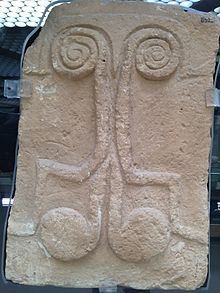Castelluccio culture

Castelluccio culture is an archaeological feature dating to Ancient Bronze Age (2000 B.C. approximately) of the prehistoric civilization of Sicily, originally identified by Paolo Orsi on the basis of a particular ceramic style, in the homonymous village, between Noto and Siracusa.[1]
The discovery of a prehistoric village in Castelluccio di Noto, next to the remains of prehistoric circular huts, a Ceramic glass decorated with brown lines on a yellow-reddish background, and also tri-colour with the use of white. The weapons used in the days of Castelluccio culture were greenstone and basalt axes and, in the most recent settlements, bronze axes. Frequently carved bones, considered idols similar to those of Malta, and of Troy II and III. Burials were made in rounded tombs carved into the rock, with doors with relief carving of spiral symbols and motifs that evoke the sexual act. Castelluccio culture is dated to a period between 2200 BC and 1800 BC,[2] although some belief it to be contemporary to Middle-Late Helladic period (1800/1400 BC).[3]
Castelluccio culture was present in the villages of south-east Sicily, Monte Casale, Cava d'Ispica, Pachino, Niscemi, Cava Lazzaro, near Noto, of Rosolini, in the rocky Byzantine district of coasts of Santa Febronia in Palagonia, in Cuddaru d' Crastu (Tornabé-Mercato d'Arrigo) near Pietraperzia, where there are the remains of a fortress partly carved in stone, and - with different ceramic forms - also near Agrigento in Monte Grande. The discovery of a cup of Etna type in the area of Comiso, among local ceramic objects led to the discovery of commercial trades with Castelluccio sites of Paternò, Adrano and Biancavilla, whose graves differ in making due to the hard basaltic terrain and also for the utilization of the lava caves as chamber tombs.
In the area around Ragusa evidence of mining by ancient Castelluccio residents has been found; tunnels excavated by the use of basalt tools allowed the extraction and production of highly sought flints. Some funerary dolmens, dated back to this same period, have been found in different parts of Sicily but are not attributable to the Castelluccio Culture.[4]
Curiosities
[edit]
The oldest olive oil in Europe was made in Castelluccio over 4000 years ago, remains of which were found in a ceramic jar and other terracotta fragments in the 1990’s. [6] The fragments of the jar were analysed by the Italian team of Decide Tanasi, which works in the American University of South Florida. Researchers have identified traces of oleic and linoleic acids, which are the signatures of olive oil in the ceramic jar found during excavations at an archaeological site in Castelluccio di Noto in the 1990s. The restorers had completely reconstructed the ceramic jar, obtained by recomposing 400 fragments; it is one meter high it has a shape of an egg, with three handles on the sides. The results were published in the Analytical Methods journal. This discovery pushes by 700 years the previous finding of the most ancient history of olive oil.[7]
See also
[edit]- Castelluccio di Noto
- Thapsos Culture
- Monte Grande (Palma di Montechiaro) [it]
- Polizzello archaeological site
- Prehistoric Italy
- Ancient peoples of Italy
Notes
[edit]- ^ Spoto, Salvatore. Sicilia Antica: Castelluccio e l'Età del bronzo, p.51.
- ^ Spoto, Salvatore. Op. cit., p.323.
- ^ Jean, Huré. Storia della Sicilia dalle Origini ai giorni nostri, p.12.
- ^ Piccolo, Salvatore. Op. cit., p.31 et seq.
- ^ Redazione (2018-06-15). "Ha 4000 anni ed è stato scoperto in Sicilia l'olio d'oliva più antico d'Europa". Fame di Sud (in Italian). Retrieved 2020-11-03.
- ^ "L'olio d'oliva più antico ha 4.000 anni - Scienza & Tecnica". ANSA.it (in Italian). 2018-05-31. Retrieved 2020-11-03.
- ^ "L'olio d'oliva più antico del mondo ha 6 mila anni ed è siciliano". www.lasicilia.it. 31 May 2018. Retrieved 2020-11-03.
Further reading
[edit]- Giuseppe Castellana (2002). La Sicilia nel II millennio a.C. Palermo: Salvatore Sciascia Editore. ISBN 88-8241-130-3.
- Jean Huré (2005). Storia della Sicilia dalle Origini ai giorni nostri. Brugherio (MI): Brancato Editore. ISBN 88-8031-078-X.
- Salvatore Piccolo (2013). Ancient Stones: the Prehistoric Dolmens of Sicily. Thornham/Norfolk (UK): Brazen Head Publishing. ISBN 978-0-9565106-2-4.
- Salvatore Spoto (2002). Sicilia Antica. Roma: Newton Compton Ed. ISBN 88-8289-750-8.
- Sebastiano Tusa (1999). La Sicilia nella Preistoria. Palermo: Sellerio Editore. ISBN 88-389-1440-0.
- Giuseppe Voza (1999). Nel segno dell'Antico. Siracusa: Arnaldo Lombardi Editore. ISBN 88-317-2606-4.
- Melchiorre Trigilia (2011). La Cava d'Ispica: archeologia storia e guida.